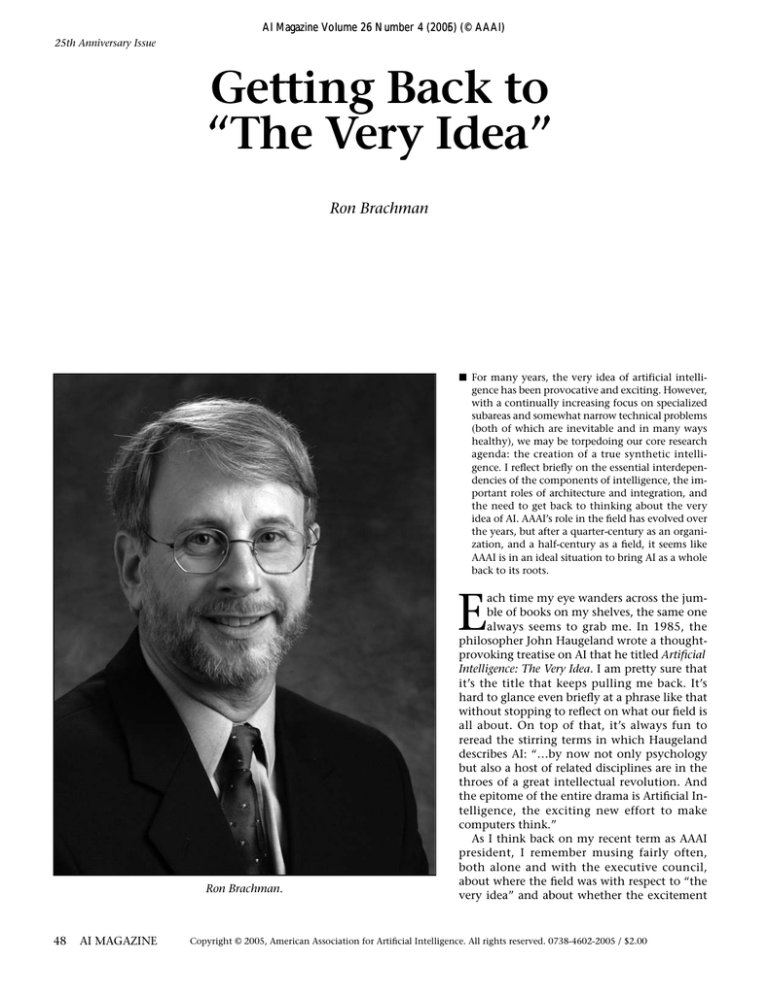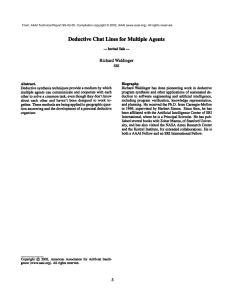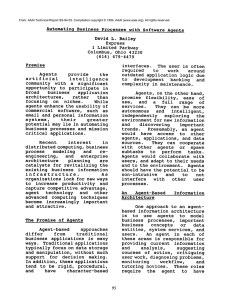
AI Magazine Volume 26 Number 4 (2005)
(2006) (© AAAI)
25th Anniversary Issue
Getting Back to
“The Very Idea”
Ron Brachman
■ For many years, the very idea of artificial intelligence has been provocative and exciting. However,
with a continually increasing focus on specialized
subareas and somewhat narrow technical problems
(both of which are inevitable and in many ways
healthy), we may be torpedoing our core research
agenda: the creation of a true synthetic intelligence. I reflect briefly on the essential interdependencies of the components of intelligence, the important roles of architecture and integration, and
the need to get back to thinking about the very
idea of AI. AAAI’s role in the field has evolved over
the years, but after a quarter-century as an organization, and a half-century as a field, it seems like
AAAI is in an ideal situation to bring AI as a whole
back to its roots.
E
Ron Brachman.
48
AI MAGAZINE
ach time my eye wanders across the jumble of books on my shelves, the same one
always seems to grab me. In 1985, the
philosopher John Haugeland wrote a thoughtprovoking treatise on AI that he titled Artificial
Intelligence: The Very Idea. I am pretty sure that
it’s the title that keeps pulling me back. It’s
hard to glance even briefly at a phrase like that
without stopping to reflect on what our field is
all about. On top of that, it’s always fun to
reread the stirring terms in which Haugeland
describes AI: “…by now not only psychology
but also a host of related disciplines are in the
throes of a great intellectual revolution. And
the epitome of the entire drama is Artificial Intelligence, the exciting new effort to make
computers think.”
As I think back on my recent term as AAAI
president, I remember musing fairly often,
both alone and with the executive council,
about where the field was with respect to “the
very idea” and about whether the excitement
Copyright © 2005, American Association for Artificial Intelligence. All rights reserved. 0738-4602-2005 / $2.00
25th Anniversary Issue
AAAI President Ron Brachman Confers with AAAI-05 Conference Cochair Manuela Veloso
at the 2005 National Conference in Pittsburgh, Pennsylvania.
and drama were still with us. In many ways, AI
has evolved to being a label on a family of relatively disconnected efforts. Extremely successful and vibrant areas, such as machine learning, robotics, and reasoning under uncertainty,
have developed their own conferences and
journals and roil with intellectual excitement
and new ideas. In some ways—as reflected by
several of my colleagues in this issue of AI Magazine—this should be counted as a great success
for our field and for AAAI as an organization
(especially in that AAAI has given birth to and
nurtured many of the specialized conferences).
The breaking up into subfields is probably an
inevitable consequence of the maturity that
fifty years of life brings to scientific pursuits.
But it has also become common for incoming
AAAI presidents and executive councilors to
wonder aloud about how we might bring the
increasingly disparate subfields of AI back together.
In our excitement about each of our own individual research areas, we may have lost sight
of the very idea of AI. As we focus on more spe-
cialized and deeper technical results in learning
algorithms and corpus-driven machine translation (for example), we are probably not thinking about the fact that even the world’s greatest
statistical classifier or the world’s best machine
translation (MT) algorithm will not end up being a fully intelligent system at the end of its research road. That per se is not an issue for machine learning or natural language processing
as individual focal subfields. But the predominance of this style of thinking is indeed an issue for AI as a larger endeavor—and, consequently, for AAAI.
As I reflected in my recent AAAI presidential
address (to be transcribed in a future issue of
this magazine), my own belief is that the
centrifugal intellectual force in our field is not
only making AAAI less of a meaningful venue
for AI scientists and practitioners—which, by
itself, would not be the end of the world: institutions can certainly outlive their usefulness
and should be replaced by new ones when they
do—it may also be having a more pernicious effect on our very research. Intelligence seems to
WINTER 2005 49
25th Anniversary Issue
Courtesy, The MIT Press
John Haugeland’s Book
was Published by The
MIT Press in 1985.
50
AI MAGAZINE
emerge from a complex combination of many
specialized abilities, such as reasoning, learning, perception, and language use. But it does
not seem to be a simple compositional result of
the mere juxtaposition of reasoning, learning,
perception, and language “boxes.” Rather,
there is some set of deep, essential interdependencies that tie these elements together: learning must result in knowledge that reasoners
can use in many different ways, perception
seems to be intrinsically guided by cognition,
and so on. If we don’t have people studying the
very idea of artificial intelligence, focusing on
architecture and interdependency, all the great
work in the world on the various pieces will
never add up to the grand dream of our field—a
true synthetic intelligence. As we spin off areas,
we may actually be destroying our real research
agenda.
One of the unique aspects of my time as
AAAI president was the concurrent privilege I
was afforded of serving as the director of the Information Processing Technology Office at the
Defense Advanced Research Projects Agency
(DARPA). DARPA—and the Information Processing Technology Office (IPTO) more specifically—has had a major impact on the history of
AI since the early 1960s, providing hundreds of
millions of dollars to the research community
in support of key efforts in the field. While a
drop in DARPA funding many years ago was at
least partly responsible for somewhat of an “AI
winter,” over my term there we were strongly
supported by the agency director and Congress
in pursuing an aggressive—and well-funded—
AI-oriented agenda. Our focus was on what we
came to call “cognitive systems,” and this allowed us to do something tangible about bringing different elements of AI together in integrated systems. Among other things, we
strongly emphasized overarching architectural
considerations for tightly integrating reasoning, learning, perception, and language use,
and we were able to help create some new
teams of people that normally would not attend the same specialized conferences or share
their results with one another. We also put considerable emphasis on the evaluation of complete, integrated AI systems, thereby challenging those teams to collaborate to satisfy metrics
that depended heavily on the components
working together. The early results are encouraging, and the funding level continues to be
significant. Both of these bode well for the future of the very idea of an artificial intelligence,
and the cognitive systems agenda may be a useful model for AAAI to use as it moves to reinvigorate its core mission.
There is only so much a single scientific or-
ganization can do to affect the social dynamic
of a field of study, but AAAI has arguably had a
profound effect on the still young field of artificial intelligence. One of the exciting things
about serving as the steward of the organization is one’s ability to make a real contribution
to its members not only by responding to their
needs but also by guiding AAAI’s resources in
helpful new directions (or in this case, helpful
old ones). As we look forward to a time of renewed excitement about the very idea of AI, I
can see AAAI playing an essential role as the
main venue for the reunification of the spunoff subfields. Having our conference and publications highlight new results in intelligent system architecture and integration of specialized
results from different areas would recapture a
unique purpose for AAAI and would bring it
back to the mission envisioned by its founders
twenty-five years ago.
Back in 1985 Haugeland suggested that AI
was “neither preposterous nor inevitable.” The
former is reassuring for those of us who have
invested our careers in the field. The latter says
that AAAI can really make a difference. After a
period of scientific dispersion in which it may
have lost a sense of the very idea it was created
to pursue, AAAI now seems on the path to resuming its starring role in the great intellectual
drama of minds and machines. I personally feel
honored to have been a small part of it. And I,
for one, am eager to see how it all turns out.
Reference
Haugeland, John 1985. Artificial Intelligence: The Very
Idea. Cambridge, MA: Bradford Books.
Ron Brachman earned his B.S.E.E. degree from
Princeton University (1971), and his S.M. (1972) and
Ph.D. (1977) degrees from Harvard University. He has
made numerous important contributions to the area
of knowledge representation, including a recent textbook with Hector Levesque, Knowledge Representation
and Reasoning. Brachman started his career at Bolt Beranek & Newman, spent several years at Fairchild/
Schlumberger’s Lab for AI Research, and, having developed a world-class AI group at AT&T Bell Laboratories, moved into senior research management jobs
at Bell Labs and AT&T Labs. He served as the director
of DARPA’s Information Processing Technology Office from 2002 to 2005, and there developed IPTO’s
cognitive systems initiative, which brought hundreds
of millions of dollars to the national research community. He recently joined Yahoo! Research as its
vice president of Worldwide Research Operations.
Brachman is a Fellow of ACM and AAAI, was program
chair for AAAI-84, and was president of AAAI from
2003–2005.





